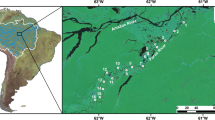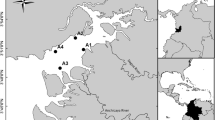Abstract
Regular patterns in seasonal occurrence of dominant fishes were observed over a six-year period in the Apalachicola estuary of north Florida. Examination of potential physico-chemical and biological community determinants has led to the hypothesis that trophic relationships and underlying physical-biological inter-actions structure this estuarine fish community. Six species (Anchoa mitchilli, Micropogonias undulatus, Leiostomus xanthurus, Cynoscion arenarius, Brevoortia patronus, and Bairdiella chrysura) comprise 85% of the trawl-susceptible fishes in the Apalachicola system, and each is characterized by distinctive seasonal abundances and trophic spectra. Two benthic omnivores (Micropogonias and Leiostomus) exhibit high spatial and temporal overlap but differ in prey type and size. These two species utilize the estuary subsequent to high river discharge/detritus input and concurrent with maximum benthic standing crops. Two epibenthic carnivores (Cynoscion and Bairdiella) also use the estuary but differ in times of peak abundances and in prey types. Two planktivores (Brevoortia and Anchoa) also frequent the estuary but during different seasons (spring and fall, respectively), yet neither cooccurs with the maximum zooplankton standing crop (summer). Anchoa is prevented from doing so by the piscivorous Cynoscion population. Thus, regular seasonal progressions of dominant fishes are linked to available trophic resources, competition, and predation, which are in turn dependent upon such factors as river flow, detrital input, plankton production, and offshore processes. The data indicate that the trophic organization of the Apalachicola estuary is highly structured and is not simply the result of a series of physically forced events superimposed over a network of trophic opportunism.
The influence of offshore shelf areas upon the observed estuarine community presently remains an enigma. Little is known concerning the interactions of shelf and estuary, and it is hoped that future research will elucidate the connections.
Access this chapter
Tax calculation will be finalised at checkout
Purchases are for personal use only
Preview
Unable to display preview. Download preview PDF.
Similar content being viewed by others
References
Carr, W. E. S. and C. A. Adams, 1972. Food habits of juvenile marine fishes: evidence of the cleaning habit in the leather jacket, Oligoplites saurus, and the spottail pinfish, Diplodus holbrooki, Fishery Bull. 70: 1111–1120.
Carr, W. E. S. and C. A. Adams, 1973. Food habits of juvenile marine fishes occupying seagrass beds in the estuarine zone near Crystal River, Florida, Trans. Amer. Fish. Soc. 102: 511–540.
Chao, L. N. and J. A. Musick, 1977. Life history, feeding habits, and functional morphology of juvenile sciaenid fishes in the York River estuary, Virginia, Fishery Bull. 75: 657–702.
Dahlberg, M. D. and E. P. Odum, 1970. Annual cycles of species occurrence, abundance, and diversity in Georgia estuarine fish populations, Amer. Midl. Nat. 83: 382–392.
Darnell, R. M., 1958. Food habits of fishes and larger invertebrates of Lake Pontchartrain, Louisiana, an estuarine community, Publ. Inst. Mar. Sci. Univ. Texas 5: 353–416.
Dunham, F., 1972. A study of commercially important estuarine- dependent industrial fishes, Tech. Bull. No. 4, 63 pp. La. Wildl. Fish. Comm.
Edmiston, H. L., 1979. The Zooplankton of Apalachicola Bay, M. S. Thesis, Florida State University.
Estabrook, R. H., 1973. Phytoplankton Ecology and Hydrography of Apalachicola Bay, M. S. Thesis, Florida State University.
Gallaway, B. J. and K. Strawn, 1974. Seasonal abundance and distribution of marine fishes at a hot-water discharge in Galveston Bay, Texas, Contrib. Mar. Sci. 18: 71–137.
Gunter, G., 1938. Seasonal variations in abundance of certain estuarine and marine fishes in Louisiana, with particular reference to life histories, Ecol. Monogr. 8: 313–346.
Gunter, G., 1945. Studies on marine fishes of Texas, Publ. Inst. Mar. Sci. Univ. Texas 1: 1–90.
Haedrich, R. L. and S. O. Haedrich, 1974. A seasonal survey of the fishes in the Mystic River, a polluted estuary in downtown Boston, Massachusetts, Est. Coastal Mar. Sci. 2: 59–73.
Hoese, H. D., 1965. Spawning of Marine Fishes in the Port Aransas Texas, Area as Determined by the Distribution of Young and Larvae, Ph.D. Dissertation, University of Texas.
Hoese, H. D., 1973. A trawl study of the nearshore fishes and invertebrates of the Georgia coast, Contrib. Mar. Sci. 17: 63–98.
Iverson, R. L. and V. B. Myers, 1976. Phytoplankton ecology of Apalachicola Bay, Florida, In: Energy Relationships and the Productivity of Apalachicola Bay, edited by R. J. Livingston, R. L. Iverson, and D. C. White, Florida Sea Grant Technical Paper, June, 1976.
Kravitz, M. J., W. G. Pearcy, and M. P. Guin, 1976. Food of five species of co-occurring flatfishes on Oregon’s continental shelf, Fishery Bull. 74: 984–990.
Lance, G. N. and W. T. Williams, 1967. A general theory of classificatory sorting strategies. I. Heirarchical systems, Computer J. 9: 373–380.
Livingston, R. J., 1976. Diurnal and seasonal fluctuations of organisms in a north Florida estuary, Est. Coastal Mar. Sci. 4: 373–400.
Livingston, R. J., 1978. Effects of clearcutting and upland deforestation activities on water quality and the biota of the Apalachicola estuary ( North Florida, U. S. A.). Final Report to Florida Sea Grant College.
Livingston, R. J., R. L. Iverson, R. H. Estabrook, V. E. Keys, and J. Taylor, Jr., 1974. Major features of the Apalachicola Bay system: physiography, biota, and resource management. Florida Scientist 37: 245–271.
Livingston, R. J., R. L. Iverson, and D. C. White, 1976a. Energy relationships and the productivity of Apalachicola Bay. Florida Sea Grant Technical Paper, June, 1976.
Livingston, R. J., G. J. Kobylinski, F. G. Lewis, III, and P. F. Sheridan, 1976b. Long-term fluctuations of epibenthic fish and invertebrate populations in Apalachicola Bay, Florida, Fishery Bull. 74: 311–321.
Livingston, R. J. and O. L. Loucks. Productivity, trophic interactions, and food web relationships in wetlands and associated systems. Proceedings of the American Water Resources Association National Symposium on Wetlands, Lake Buena Vista, Florida, November, 1978. In press.
Livingston, R. J., P. F. Sheridan, B. G. McLane, F. G. Lewis, III, and G. J. Kobylinski, 1977. The biota of the Apalachicola Bay system: functional relationships, In: Proceedings of the Conference on the Apalachicola Drainage System, edited by R. J. Livingston and E. A. Joyce, Jr., 75–100, Fla. Dept. Nat. Res., Mar. Res. Publ. 26.
Livingston, R. J., N. P. Thompson, and D. A. Meeter, 1978. Long-term variation of organochlorine residues and assemblages of epibenthic organisms in a shallow north Florida (USA) estuary. Mar. Biol. 46: 355–372.
McEachran, J. D., D. F. Boesch, and J. A. Musick, 1976. Food division within two sympatric species-pairs of skates (Pisces: Rajidae). Mar. Biol. 35: 301–317.
McErlean, A. J., S. G. O’Connor, J. A. Mihursky, and C. I. Gibson, 1973. Abundance, diversity and seasonal patterns of estuarin fish populations, Est. Coastal Mar. Sci. 1: 19–36.
Matusita, K., 1955. Decision rules based on the distance for problems of fit, two samples and estimation, Ann. Math. Statist. 26: 631–640.
Moe, M. A., Jr., and G. T. Martin, 1965. Fishes taken in monthly trawl samples offshore of Pinellas County, Florida, with new additions to the fish fauna of the Tampa Bay area, Tulane Stud. Zool. 12: 129–151.
Oviatt, C. A. and S. W. Nixon, 1973. The demersal fish of Narragansett Bay: an analysis of community structure, distribution and abundance, Est. Coastal Mar. Sci. 1: 361–378.
Pearson, J. C., 1928. Natural history and conservation of the redfish and other commercial sciaenids on the Texas coast, Bull. U. S. Bur. Fish. 44: 129–214.
Perret, W. S., 1971. Cooperative Gulf of Mexico estuarine inventory and study, Louisiana. Phase IV, Biology, 175 pp., La. Wildl. Fish. Comm., New Orleans.
Reid, G. K., Jr., 1954. An ecological study of the Gulf of Mexico fishes in the vicinity of Cedar Key, Florida, Bull. Mar. Sci. Gulf Caribb. 4: 1–94.
Roelofs, E. W., 1954. Food studies of young sciaenid fishes, Micropogon and Leiostomus, from North Carolina, Copeia 1954: 151–153.
Sheridan, P. F., 1978. Trophic Relationships of Dominant Fishes in Apalachicola Bay (Florida), Ph.D. Dissertation, Florida State University.
Springer, V. G. and K. D. Woodburn, 1960. An ecological study of the fishes of the Tampa Bay area. Mar. Res. Lab. Prof. Papers Ser. 1. 104 pp., Fla. Dept. Nat. Res.
Stickney, R. R., G. L. Taylor, and R. W. Heard, III, 1974. Food habits of Georgia estuarine fishes. I. Four species of flounders (Pleuronectiformes: Bothidae), Fishery Bull. 72: 515–525.
Stickney, R. R., G. L. Taylor and D. B. White, 1975. Food habits of five species of young southeastern United States estuarine Sciaenidae, Chesapeake Sci. 16: 104–114.
Suttkus, R. D., 1956. Early life history of the Gulf menhaden, Brevoortia patronusin Louisiana, Trans. N. Amer. Wildl. Conf. 21: 309–407.
Tabb, D. C. and R. B. Manning, 1961. A checklist of the flora and fauna of northern Florida Bay and adjacent brackish waters of the Florida mainland collected during the period July, 1957, through September, 1960, Bull. Mar. Sci. Gulf Caribb. 11: 552–649.
Tyler, A. V., 1972. Food resource division among northern, marine demersal fishes, J. Fish. Res. Bd Canada 29: 997–1003.
Van Belle, G. and I. Ahmad, 1974. Measuring affinity of distributions, In: Reliability and Biometry: Statistical Analysis of Life Length, edited by F. Proschan and R. J. Serfling, 651–668, S. I. A. M., Philadelphia.
Author information
Authors and Affiliations
Editor information
Editors and Affiliations
Rights and permissions
Copyright information
© 1979 Plenum Press, New York
About this chapter
Cite this chapter
Sheridan, P.F., Livingston, R.J. (1979). Cyclic Trophic Relationships of Fishes in an Unpolluted, River-Dominated Estuary in North Florida. In: Livingston, R.J. (eds) Ecological Processes in Coastal and Marine Systems. Marine Science, vol 10. Springer, Boston, MA. https://doi.org/10.1007/978-1-4615-9146-7_8
Download citation
DOI: https://doi.org/10.1007/978-1-4615-9146-7_8
Publisher Name: Springer, Boston, MA
Print ISBN: 978-1-4615-9148-1
Online ISBN: 978-1-4615-9146-7
eBook Packages: Springer Book Archive




